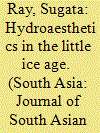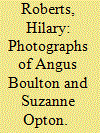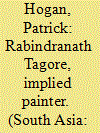| Srl | Item |
| 1 |
ID:
153011


|
|
|
|
|
| Summary/Abstract |
Examining the visual tactics of framing flowing water in landscape painting and riparian architecture in Braj, a pilgrimage centre in North India where the god Krishna is believed to have spent his youth, the essay foregrounds a new conception of hydroaesthetics that emerged with the onset of the Little Ice Age (c. 1550–1850), a climatic period marked by catastrophic droughts and famines in South Asia. An engagement with the hydroaesthetics of beholding the river Yamuna's passage through Braj, the essay argues, brings to the forefront a reciprocal relationship between artistic practices based on a theological aesthetic of venerating the natural environment and ecological calamities. In doing so, the essay attempts to delineate a possible methodology for an ecological art history.
|
|
|
|
|
|
|
|
|
|
|
|
|
|
|
|
| 2 |
ID:
092449


|
|
|
|
|
| Publication |
2009.
|
| Summary/Abstract |
In comparison to some media, such as sculpture or painting, photography has a relatively short history.
|
|
|
|
|
|
|
|
|
|
|
|
|
|
|
|
| 3 |
ID:
110860


|
|
|
|
|
| Publication |
2012.
|
| Summary/Abstract |
This essay examines the idea of implied authorship in relation to painting. It considers a painting by Tagore, arguing that enigmas in the painting may be partially resolved by reference to ideas from a range of Tagore's works. This suggests that, beyond the implied author of a particular work, we should consider the implied author across a canon of works. This canonical implied author does not substitute for the implied author of an individual work. However, it provides one important context for interpretation. Moreover, it does not render the work unequivocal, but alters the profile of ambiguity of the work.
|
|
|
|
|
|
|
|
|
|
|
|
|
|
|
|
| 4 |
ID:
157843


|
|
|
|
|
| Summary/Abstract |
A considerable amount of scholarship has been produced on just over sixty paintings of humans and demons, many of which bear ascriptions to the unidentified artist Mohammad-e Siāh Qalam, and which are now mostly housed in albums H.2153 and H.2160 in the Topkapı Palace Library. Although methods of formal comparison have led to general agreement that the paintings can be dated to either the fourteenth century or the fifteenth, strikingly little attention has been paid to the question of what these images depict. This paper studies the paintings within the context of documentary, legal and literary material in Persian and Arabic, and identifies a set of common motifs shared between the Siāh Qalam paintings and a number of later images. While it has been supposed by several scholars that the paintings document life in a marginal geographical environment and faithfully reflect the practices of a syncretic culture, this paper suggests that they engage with a field of satirical ideas which were widespread in the Islamic world in the fourteenth and fifteenth centuries, and which parodied common types of behavior that were deemed by some observers to be illicit or absurd.
|
|
|
|
|
|
|
|
|
|
|
|
|
|
|
|